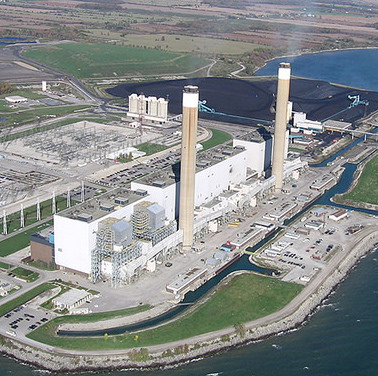Ontario to convert largest coal plant in North America to solar farm

An aerial view of the Nanticoke Generating Station in 2007, when it was still operating. The plant will be converted to a 44-megawatt solar panel farm
An aerial view of the Nanticoke Generating Station in 2007, when it was still operating. The plant will be converted to a 44-megawatt solar panel farm. — Photo courtesy Ontario Power Generation
The Nanticoke Generating Station in southwestern Ontario used to be the largest coal-fired electricity-generating plant in North America, but recently the facility has committed to going green.
The former serial emitter of greenhouse gasses will be converted to a 44-megawatt (MW) solar panel farm.
Nanticoke stopped producing electrical power in 2013 as part of Ontario’s phase-out of coal energy. The enormous plant, which could produce almost 4,000 MW of power at full capacity, was shuttered for safety reasons in 2015.
But the strip of land on the north shore of Lake Erie is slated to come to life again, producing the electricity Ontario needs but this time without the undesired greenhouse gas emissions.
Ontario Power Generation (OPG), Six Nations Development Corporation and SunEdison Canadian Construction LP are partners in the project.
“Together we are moving ahead with approvals so that construction can begin as early as late 2017,” said OPG spokesman Neal Kelly. “Completion of the project is expected to be in 2019.”
Michelle Chislett, SunEdison vice-president and country manager for Canada, said in an announcement, “The Nanticoke project is a great opportunity for Ontario to take a former coal plant site and transform it into a clean and reliable solar power plant.”
The redevelopment is part of the (Ontario) Independent Electricity System Operator’s (IESO) Large Renewable Procurement (LRP) program.
The Nanticoke development is one of seven solar projects totaling 140 MW that IESO awarded in Phase 1 of the LRP.
“The project to convert the Nanticoke power plant into a solar facility is one of 16 project proposals awarded a contract under Phase l of the Large Renewable Procurement,” said IESO spokesman John Cannella.
The LRP is a competitive process for procuring large renewable energy projects generally that are larger than 500 kilowatts. Targets for the first procurement included up to 300 MW of wind, 140 MW of solar, 50 MW of bioenergy and 75 MW of waterpower.
One of the component parts of the former Ontario Hydro, like OPG, IESO wears many hats.
The organization is responsible for planning the power system, real-time operating of the grid, running the electricity market, enabling conservation across Ontario and procuring electricity supply.
The IESO is also the contract counterparty for the project.
“This is part of the IESO’s function to ensure sufficient generation is available to meet Ontario’s needs,” Cannella said.
According to Cannella, projects awarded a contract under the LRP are an important ingredient in Ontario’s commitment to building a cleaner and more sustainable energy system.
“The LRP is a key step in the province’s 2025 target for renewable energy of 20,000 megawatts by 2025, or about one-half of Ontario's installed capacity,” he said.
Proponents of Ontario’s clean energy initiatives say the province’s move from coal-fired generation will have health benefits for Ontarians.
Before it was idled, Nanticoke was one of Canada’s worst polluters. Many people believe that coal-generated power in Ontario was one of the main causes of the province’s smoggy skies in summer.
Ontario's energy capacity and output
The Independent Electricity System Operator oversees Ontario's electricity system. It forecasts daily demand for electricity and operates in real time to ensure an adequate supply is always available.
Electricity in Ontario has a number of different sources of supply: nuclear, gas, hydro, wind, biofuel and solar.
Nuclear and large hydroelectric sites operate all the time and provide a steady output known as baseload generation.
Other generation types, such as gas and some hydroelectric stations, increase production during peak periods of demand.
There are dozens of hydro generating stations across Ontario. The largest producers are the Sir Adam Beck Generating Station on the Niagara River, the Saunders Power Dam on the St. Lawrence River and Des Joachims GS on the Ottawa River.
In 2013, the Adam Beck II Station brought into service a four-storey tunnel underneath downtown Niagara Falls. The tunnel diverts water from the Niagara River above the Horseshoe Falls and carries it on a downward slope to the generating station more than10 kilometres away, increasing the station's generating capacity.
Variable generation, such as wind and solar, produce energy depending on how much wind and sunlight is available.
The Independent Electricity System Operator oversees Ontario's electricity system. It forecasts daily demand for electricity and operates in real time to ensure an adequate supply is always available.
Electricity in Ontario has a number of different sources of supply: nuclear, gas, hydro, wind, biofuel and solar.
Nuclear and large hydroelectric sites operate all the time and provide a steady output known as baseload generation.
Other generation types, such as gas and some hydroelectric stations, increase production during peak periods of demand.
There are dozens of hydro generating stations across Ontario. The largest producers are the Sir Adam Beck Generating Station on the Niagara River, the Saunders Power Dam on the St. Lawrence River and Des Joachims GS on the Ottawa River.
In 2013, the Adam Beck II Station brought into service a four-storey tunnel underneath downtown Niagara Falls. The tunnel diverts water from the Niagara River above the Horseshoe Falls and carries it on a downward slope to the generating station more than10 kilometres away, increasing the station's generating capacity.
Variable generation, such as wind and solar, produce energy depending on how much wind and sunlight is available.


